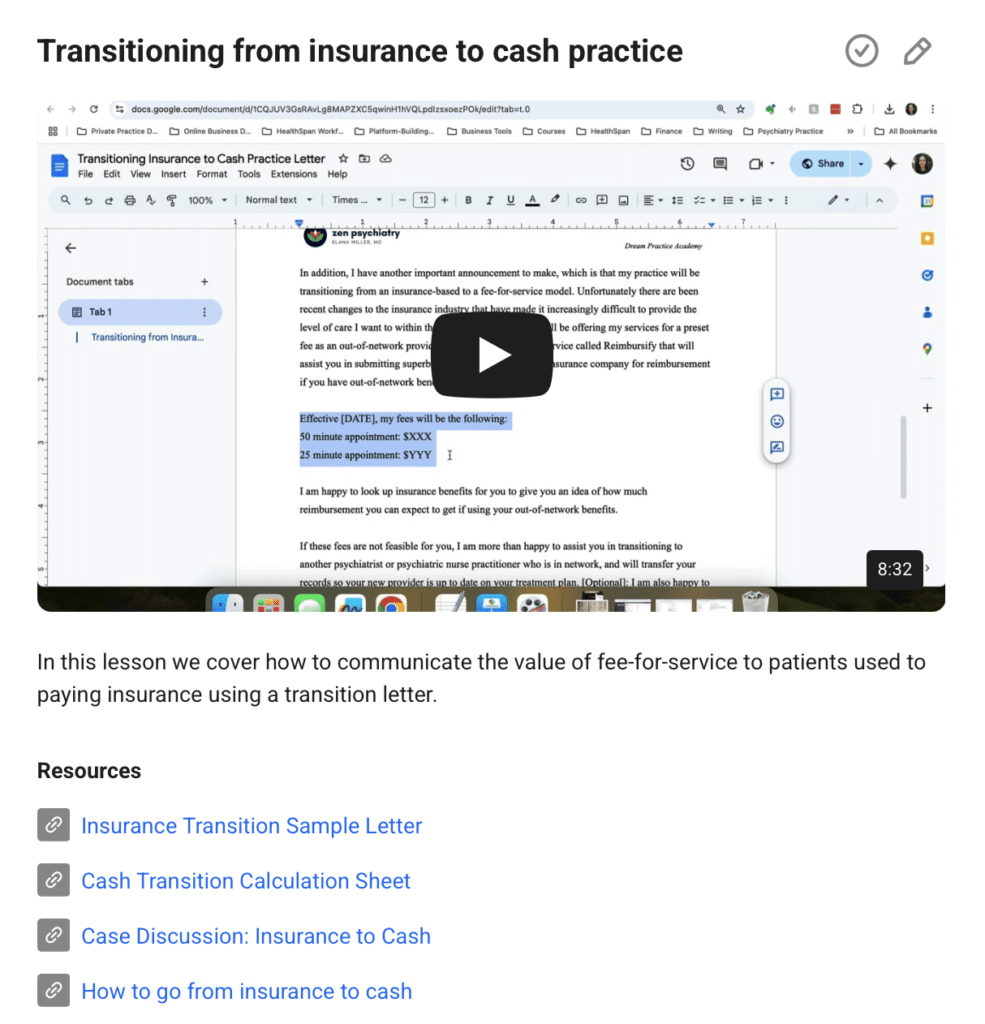
If you’re currently running an insurance-based psychiatry private practice—or seeing patients through platforms like Alma, Headway, or Grow—you’ve probably thought about transitioning to a cash-pay model. Maybe you’re tired of settling for low reimbursements, drowning in paperwork, or feeling like you can’t give patients the time and attention they deserve.
But here’s the big question that might be holding you back:
“Will my patients leave if I stop taking insurance?”
The good news? They don’t have to.
With the right strategy, you can retain 30–50% (or more) of your current patients while attracting new ones who value comprehensive, personalized care. Below is your roadmap to transition to cash and keep your psychiatry private practice thriving.
Step 1: Build Your Patient Base Before Transitioning to Cash
Dropping insurance might feel like the quick way out of frustration, but trust me—it’s much smoother when you plan ahead.
Start by building your patient base while you’re still accepting insurance.
Why this works:
- Patients trust you. Existing patients who already know the value of your care are more likely to stay when you transition to cash.
- Financial stability. Maintaining insurance patients ensures a steady income as you prepare to switch.
- Confidence in your systems. You’ll have time to fine-tune workflows and processes before making a major change.
For more tips on growing and optimizing your private practice, check out my recent blog post: How to Optimize & Scale Your Private Practice.
Step 2: Highlight the Value of Cash-Based Care
When patients hear “cash-only,” their first thought might be “expensive.” This is where you need to reframe the conversation and focus on what they’re gaining—not just what they’re paying.
Here’s what your patients get with cash-based care:
- Longer, more meaningful appointments. Say goodbye to 15-minute med checks that barely scratch the surface.
- A holistic approach to psychiatry. You’re free to offer care that goes beyond the limits of insurance, including nutrition counseling, supplements, and lifestyle coaching.
- Streamlined, personalized care. No more barriers from insurance companies telling you what you can and can’t do for your patients.
If you’d like to explore the differences between traditional and integrative psychiatry further, I’ve written about it here.

Step 3: Offer Options to Help Patients Transition
It’s inevitable that some patients won’t be able to stay when you stop accepting insurance. That’s okay—your focus should be on supporting those who can and providing thoughtful alternatives for those who can’t.
Here are a few ways to help patients transition:
- Out-of-Network Reimbursement
Many insurance plans offer out-of-network benefits. Show your patients how to submit claims, and recommend tools like Reimbursify or SuperBill to make it easier. - Time-Limited Sliding Scale
To ease the financial burden for long-term patients, consider offering a sliding scale for the first 3–6 months. - Thoughtful Referrals
If a patient can’t stay, provide referrals to trusted providers who take their insurance. This shows you’re invested in their well-being—even if they leave your practice.
Step 4: Communicate Early and Often
The key to a smooth transition is clear, proactive communication. Start notifying patients 3–6 months in advance and address their concerns early.
Here’s what to include in your communication:
- Your “why.” Explain that transitioning to cash allows you to offer longer appointments, personalized care, and fewer barriers to treatment.
- The benefits. Reassure patients that this change is about improving the quality of care, not just about money.
- Their options. Outline tools for reimbursement, sliding scales, or referrals for those who can’t continue care.
To make this process easier, I’ve created a transition announcement letter template that you can customize and share with your patients. This resource is designed to help you explain the change, highlight the benefits of cash-based care, and address common concerns like affordability or reimbursement.

I’ve also included a video guide that walks you through how to use the letter, handle patient concerns, and offer optional sliding-scale fees for patients who need financial flexibility.
Fill out the form below to get access to this free resource:
Step 5: Get Financial Clarity on Transitioning to Cash

Finances are one of the biggest concerns for clinicians transitioning to cash-pay. You might be wondering:
- How much do I need to charge to sustain my practice?
- How many patients do I need to retain to cover my expenses and income goals?
Inside my free Dream Practice School, I’ve included a financial planning tool that helps you calculate the numbers. This resource walks you through:
- Analyzing your current patient panel and monthly revenue.
- Determining your ideal cash-pay rates for different appointment types.
- Estimating how many patients you’ll need to retain or attract to make the transition financially successful.
When you have clarity about your finances, the leap to cash-pay feels far less overwhelming—and much more achievable.
Join Dream Practice School now to access this resource!
Step 6: Attract Patients Who Value Your Care
Here’s the beauty of transitioning to a cash-pay psychiatry private practice: you’ll naturally attract patients who truly value your care. These are patients who:
- Want longer, more meaningful appointments.
- Value holistic and personalized treatment.
- Are willing to invest in their mental health for better outcomes.
To attract these patients:
- Optimize your Psychology Today profile. Highlight your unique approach, such as integrative psychiatry or longer appointments.
- Build referral networks. Partner with therapists, functional medicine providers, and wellness professionals who can refer patients to you.
- Use content marketing. Share blogs, videos, or social media posts that explain your philosophy of care.
Patients who resonate with your approach will naturally gravitate toward your practice.

The Benefits of Transitioning to a Cash-Pay Psychiatry Private Practice
Switching to cash-pay is about more than changing your payment structure—it’s about creating a psychiatry private practice that aligns with your values and allows you to provide exceptional care.
With thoughtful planning, clear communication, and financial clarity, you can create a sustainable and fulfilling practice that works for you and your patients.
If you’re ready to take the next step, get your free copy of my transition announcement letter and video guide and check out my financial planning tool inside Dream Practice School. These resources will give you the confidence and clarity you need to make the leap.


Leave a Reply